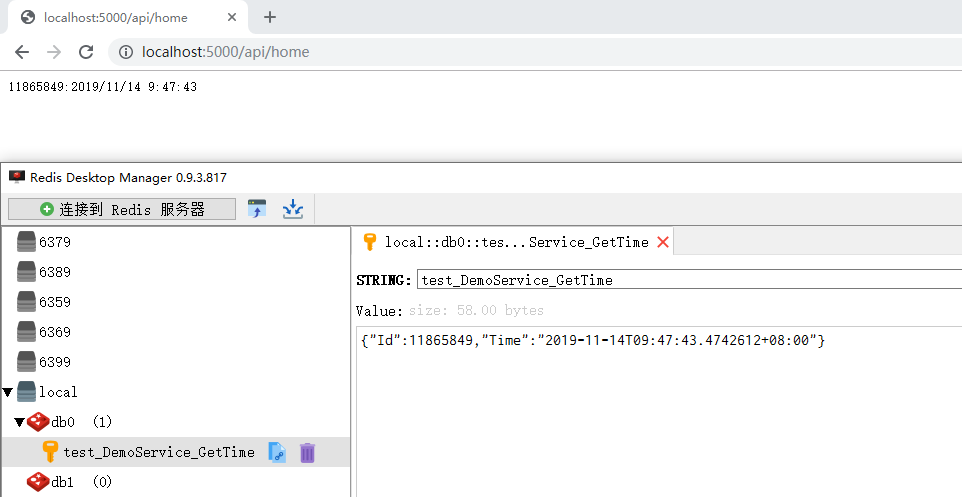使用AspectCore实现AOP模式的Redis缓存
这次的目标是实现通过标注Attribute实现缓存的功能,精简代码,减少缓存的代码侵入业务代码。
缓存内容即为Service查询汇总的内容,不做其他高大上的功能,提升短时间多次查询的响应速度,适当减轻数据库压力。
在做之前,也去看了EasyCaching的源码,这次的想法也是源于这里,AOP的方式让代码减少耦合,但是缓存策略有限。经过考虑决定,自己实现类似功能,在之后的应用中也方便对缓存策略的扩展。
本文内容也许有点不严谨的地方,仅供参考。同样欢迎各位路过的大佬提出建议。
在项目中加入AspectCore
之前有做AspectCore的总结,相关内容就不再赘述了。
在项目中加入Stackexchange.Redis
在stackexchange.Redis和CSRedis中纠结了很久,也没有一个特别的有优势,最终选择了stackexchange.Redis,没有理由。至于连接超时的问题,可以用异步解决。
- 安装Stackexchange.Redis
Install-Package StackExchange.Redis -Version 2.0.601
- 在appsettings.json配置Redis连接信息
{
"Redis": {
"Default": {
"Connection": "127.0.0.1:6379",
"InstanceName": "RedisCache:",
"DefaultDB": 0
}
}
}
- RedisClient
用于连接Redis服务器,包括创建连接,获取数据库等操作
public class RedisClient : IDisposable
{
private string _connectionString;
private string _instanceName;
private int _defaultDB;
private ConcurrentDictionary<string, ConnectionMultiplexer> _connections;
public RedisClient(string connectionString, string instanceName, int defaultDB = 0)
{
_connectionString = connectionString;
_instanceName = instanceName;
_defaultDB = defaultDB;
_connections = new ConcurrentDictionary<string, ConnectionMultiplexer>();
}
private ConnectionMultiplexer GetConnect()
{
return _connections.GetOrAdd(_instanceName, p => ConnectionMultiplexer.Connect(_connectionString));
}
public IDatabase GetDatabase()
{
return GetConnect().GetDatabase(_defaultDB);
}
public IServer GetServer(string configName = null, int endPointsIndex = 0)
{
var confOption = ConfigurationOptions.Parse(_connectionString);
return GetConnect().GetServer(confOption.EndPoints[endPointsIndex]);
}
public ISubscriber GetSubscriber(string configName = null)
{
return GetConnect().GetSubscriber();
}
public void Dispose()
{
if (_connections != null && _connections.Count > 0)
{
foreach (var item in _connections.Values)
{
item.Close();
}
}
}
}
- 注册服务
Redis是单线程的服务,多几个RedisClient的实例也是无济于事,所以依赖注入就采用singleton的方式。
public static class RedisExtensions
{
public static void ConfigRedis(this IServiceCollection services, IConfiguration configuration)
{
var section = configuration.GetSection("Redis:Default");
string _connectionString = section.GetSection("Connection").Value;
string _instanceName = section.GetSection("InstanceName").Value;
int _defaultDB = int.Parse(section.GetSection("DefaultDB").Value ?? "0");
services.AddSingleton(new RedisClient(_connectionString, _instanceName, _defaultDB));
}
}
public class Startup
{
public void ConfigureServices(IServiceCollection services)
{
services.ConfigRedis(Configuration);
}
}
- KeyGenerator
创建一个缓存Key的生成器,以Attribute中的CacheKeyPrefix作为前缀,之后可以扩展批量删除的功能。被拦截方法的方法名和入参也同样作为key的一部分,保证Key值不重复。
public static class KeyGenerator
{
public static string GetCacheKey(MethodInfo methodInfo, object[] args, string prefix)
{
StringBuilder cacheKey = new StringBuilder();
cacheKey.Append($"{prefix}_");
cacheKey.Append(methodInfo.DeclaringType.Name).Append($"_{methodInfo.Name}");
foreach (var item in args)
{
cacheKey.Append($"_{item}");
}
return cacheKey.ToString();
}
public static string GetCacheKeyPrefix(MethodInfo methodInfo, string prefix)
{
StringBuilder cacheKey = new StringBuilder();
cacheKey.Append(prefix);
cacheKey.Append($"_{methodInfo.DeclaringType.Name}").Append($"_{methodInfo.Name}");
return cacheKey.ToString();
}
}
写一套缓存拦截器
- CacheAbleAttribute
Attribute中保存缓存的策略信息,包括过期时间,Key值前缀等信息,在使用缓存时可以对这些选项值进行配置。
public class CacheAbleAttribute : Attribute
{
/// <summary>
/// 过期时间(秒)
/// </summary>
public int Expiration { get; set; } = 300;
/// <summary>
/// Key值前缀
/// </summary>
public string CacheKeyPrefix { get; set; } = string.Empty;
/// <summary>
/// 是否高可用(异常时执行原方法)
/// </summary>
public bool IsHighAvailability { get; set; } = true;
/// <summary>
/// 只允许一个线程更新缓存(带锁)
/// </summary>
public bool OnceUpdate { get; set; } = false;
}
- CacheAbleInterceptor
接下来就是重头戏,拦截器中的逻辑就相对于缓存的相关策略,不用的策略可以分成不同的拦截器。
这里的逻辑参考了EasyCaching的源码,并加入了Redis分布式锁的应用。
public class CacheAbleInterceptor : AbstractInterceptor
{
[FromContainer]
private RedisClient RedisClient { get; set; }
private IDatabase Database;
private static readonly ConcurrentDictionary<Type, MethodInfo> TypeofTaskResultMethod = new ConcurrentDictionary<Type, MethodInfo>();
public async override Task Invoke(AspectContext context, AspectDelegate next)
{
CacheAbleAttribute attribute = context.GetAttribute<CacheAbleAttribute>();
if (attribute == null)
{
await context.Invoke(next);
return;
}
try
{
Database = RedisClient.GetDatabase();
string cacheKey = KeyGenerator.GetCacheKey(context.ServiceMethod, context.Parameters, attribute.CacheKeyPrefix);
string cacheValue = await GetCacheAsync(cacheKey);
Type returnType = context.GetReturnType();
if (string.IsNullOrWhiteSpace(cacheValue))
{
if (attribute.OnceUpdate)
{
string lockKey = $"Lock_{cacheKey}";
RedisValue token = Environment.MachineName;
if (await Database.LockTakeAsync(lockKey, token, TimeSpan.FromSeconds(10)))
{
try
{
var result = await RunAndGetReturn(context, next);
await SetCache(cacheKey, result, attribute.Expiration);
return;
}
finally
{
await Database.LockReleaseAsync(lockKey, token);
}
}
else
{
for (int i = 0; i < 5; i++)
{
Thread.Sleep(i * 100 + 500);
cacheValue = await GetCacheAsync(cacheKey);
if (!string.IsNullOrWhiteSpace(cacheValue))
{
break;
}
}
if (string.IsNullOrWhiteSpace(cacheValue))
{
var defaultValue = CreateDefaultResult(returnType);
context.ReturnValue = ResultFactory(defaultValue, returnType, context.IsAsync());
return;
}
}
}
else
{
var result = await RunAndGetReturn(context, next);
await SetCache(cacheKey, result, attribute.Expiration);
return;
}
}
var objValue = await DeserializeCache(cacheKey, cacheValue, returnType);
//缓存值不可用
if (objValue == null)
{
await context.Invoke(next);
return;
}
context.ReturnValue = ResultFactory(objValue, returnType, context.IsAsync());
}
catch (Exception)
{
if (context.ReturnValue == null)
{
await context.Invoke(next);
}
}
}
private async Task<string> GetCacheAsync(string cacheKey)
{
string cacheValue = null;
try
{
cacheValue = await Database.StringGetAsync(cacheKey);
}
catch (Exception)
{
return null;
}
return cacheValue;
}
private async Task<object> RunAndGetReturn(AspectContext context, AspectDelegate next)
{
await context.Invoke(next);
return context.IsAsync()
? await context.UnwrapAsyncReturnValue()
: context.ReturnValue;
}
private async Task SetCache(string cacheKey, object cacheValue, int expiration)
{
string jsonValue = JsonConvert.SerializeObject(cacheValue);
await Database.StringSetAsync(cacheKey, jsonValue, TimeSpan.FromSeconds(expiration));
}
private async Task Remove(string cacheKey)
{
await Database.KeyDeleteAsync(cacheKey);
}
private async Task<object> DeserializeCache(string cacheKey, string cacheValue, Type returnType)
{
try
{
return JsonConvert.DeserializeObject(cacheValue, returnType);
}
catch (Exception)
{
await Remove(cacheKey);
return null;
}
}
private object CreateDefaultResult(Type returnType)
{
return Activator.CreateInstance(returnType);
}
private object ResultFactory(object result, Type returnType, bool isAsync)
{
if (isAsync)
{
return TypeofTaskResultMethod
.GetOrAdd(returnType, t => typeof(Task)
.GetMethods()
.First(p => p.Name == "FromResult" && p.ContainsGenericParameters)
.MakeGenericMethod(returnType))
.Invoke(null, new object[] { result });
}
else
{
return result;
}
}
}
- 注册拦截器
在AspectCore中注册CacheAbleInterceptor拦截器,这里直接注册了用于测试的DemoService,
在正式项目中,打算用反射注册需要用到缓存的Service或者Method。
public static class AspectCoreExtensions
{
public static void ConfigAspectCore(this IServiceCollection services)
{
services.ConfigureDynamicProxy(config =>
{
config.Interceptors.AddTyped<CacheAbleInterceptor>(Predicates.Implement(typeof(DemoService)));
});
services.BuildAspectInjectorProvider();
}
}
测试缓存功能
- 在需要缓存的接口/方法上标注Attribute
[CacheAble(CacheKeyPrefix = "test", Expiration = 30, OnceUpdate = true)]
public virtual DateTimeModel GetTime()
{
return new DateTimeModel
{
Id = GetHashCode(),
Time = DateTime.Now
};
}
- 测试结果截图
请求接口,返回时间,并将返回结果缓存到Redis中,保留300秒后过期。

相关链接
使用AspectCore实现AOP模式的Redis缓存的更多相关文章
- 今日份学习: Spring中使用AOP并实现redis缓存?
笔记 在Spring中如何使用AOP? Spring是如何切换JDK动态代理和CGLIB的? spring.aop.proxy-target-class=true (在下方第二个链接中,原生doc中提 ...
- 聊聊在AOP模式下的缓存方案
面向方法的数据集缓存 使用了autofac做为ioc容器,使用Autofac.Extras.DynamicProxy2作为方法拦截器,缓存面向方法,直接在方法上添加CachingAttribute特性 ...
- ssm+redis 如何更简洁的利用自定义注解+AOP实现redis缓存
基于 ssm + maven + redis 使用自定义注解 利用aop基于AspectJ方式 实现redis缓存 如何能更简洁的利用aop实现redis缓存,话不多说,上demo 需求: 数据查询时 ...
- spring aop搭建redis缓存
SpringAOP与Redis搭建缓存 近期项目查询数据库太慢,持久层也没有开启二级缓存,现希望采用Redis作为缓存.为了不改写原来代码,在此采用AOP+Redis实现. 目前由于项目需要,只需要做 ...
- 十二:SpringBoot-基于Cache注解模式,管理Redis缓存
SpringBoot-基于Cache注解模式,管理Redis缓存 1.Cache缓存简介 2.核心API说明 3.SpringBoot整合Cache 3.1 核心依赖 3.2 Cache缓存配置 3. ...
- 第04项目:淘淘商城(SpringMVC+Spring+Mybatis)【第七天】(redis缓存)
https://pan.baidu.com/s/1bptYGAb#list/path=%2F&parentPath=%2Fsharelink389619878-229862621083040 ...
- 缓存工厂之Redis缓存
这几天没有按照计划分享技术博文,主要是去医院了,这里一想到在医院经历的种种,我真的有话要说:医院里的医务人员曾经被吹捧为美丽+和蔼+可亲的天使,在经受5天左右相互接触后不得不让感慨:遇见的有些人员在挂 ...
- Windows Azure Redis 缓存服务
8月20日,Windows Azure (中国版)开始提供Redis缓存服务,比较国际版的Microsoft Azure晚了差不多一年的时间.说实话,微软真不应该将这个重要的功能delay这么长时间, ...
- memcache/redis 缓存学习笔记
0.redis和memcache的区别 a.redis可以存储除了string之外的对象,如list,hash等 b.服务器宕机以后,redis会把内存的数据持久化到磁盘上,而memcache则不会 ...
随机推荐
- 无法打开锁文件 /var/lib/dpkg/lock-frontend - open
转自:https://blog.csdn.net/sinat_29957455/article/details/89036005 在使用apt-get安装程序的时候报: E: 无法打开锁文件 /var ...
- zTree插件的应用
需要用到的js和css文件 <link rel="stylesheet" href="__PUBLIC__/zTree/css/demo.css" typ ...
- Java生鲜电商平台-微服务入门与服务的拆分架构实战
Java生鲜电商平台-微服务入门与服务的拆分架构实战 刚开始进入软件行业时还是单体应用的时代,前后端分离的概念都还没普及,开发的时候需要花大量的时间在“强大”的JSP上面,那时候SOA已经算是新技术了 ...
- maven下载,安装,配置
Eclipse配置maven 官网:http://maven.apache.org/ 1.解压你在maven下载到的压缩包,一般把它和jdk放在一起. 2.安装maven在电脑上. 鼠标右键点击计算 ...
- 【Android】基于A星寻路算法的简单迷宫应用
简介 基于[漫画算法-小灰的算法之旅]上的A星寻路算法,开发的一个Demo.目前实现后退.重新载入.路径提示.地图刷新等功能.没有做太多的性能优化,算是深化对A星寻路算法的理解. 界面预览: 初始化: ...
- 使用百度的webuploader进行附件上传
相较于之前使用的上传空间的优点:支持html5,不用再安装flash插件,没有大小限制,分片以后上传,上传以后再进行合并. 前端js代码 <script type="text/java ...
- 【LeetCode】1056-易混淆数
易混淆数 给定一个数字 N,当它满足以下条件的时候返回 true:把原数字旋转180°以后得到新的数字.如 0, 1, 6, 8, 9 旋转 180° 以后,得到了新的数字 0, 1, 9, 8, 6 ...
- Mysql 索引精讲
Mysql 索引精讲 开门见山,直接上图,下面的思维导图即是现在要讲的内容,可以先有个印象- 常见索引类型(实现层面) 索引种类(应用层面) 聚簇索引与非聚簇索引 覆盖索引 最佳索引使用策略 1.常见 ...
- git零基础快速入门实战,重点讲解,在实际生产中整合idea对版本、分支的管理等
1.什么是版本管理 (多人协作)项目中常见的问题: 代码放在什么地方 ?? 同步(到服务器),代码的冲突问题 ?? 服务器访问权限问题 ?? (代码)服务器内容修改的细节 ?? 项目版本的发布 ?? ...
- 字符串和id的转换方法
在项目中经常会遇到一个需求就是字符串和id的转换,比如标签和标签id.因为在存储系统里面存储字符串会比较浪费内存,而存储id会节省内存和提高效率. 问题分解 通过字符串获得id 通过id获得字符串 实 ...
